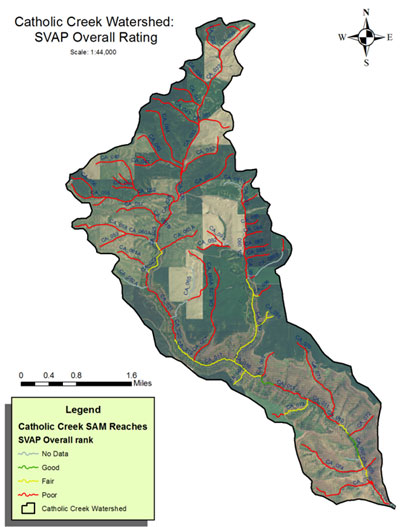Agricultural lands in the upland portion of the watershed are identified for treatment and are the major contributor to the identified problems listed under Fish Habitat, Flow, Sediment, and Stream Temperatures.
Any agricultural lands which received a poor or fair stream condition rating need treatment to improve their condition to good or excellent. Figure 1 illustrates the location of stream reaches with poor and fair condition ratings.
Figure 1. Stream condition rating map.

Treatment Action Recommendations for the Agricultural Uplands
- Riparian plantings consisting of forb, tree, and shrub components are recommended for all areas where adequate riparian zones do not exist.
- Conservation easements should be used where feasible.
- Vegetative buffers, including both filter strips and riparian plantings, are needed in cropland areas where tillage occurs adjacent to the stream channels.
- Wetland restoration and enhancement, including the removal of drain tiles and wetland plantings, is recommended where historic wetlands were once located in the uplands.
- Where livestock grazing occurs, improved grazing management, riparian fencing, and off-stream water developments should be employed.
- Dikes and berms that tend to limit floodplain access, potentially leading to channelization, incision, and straightening should be removed or modified. This may include off-set dikes, removal of fill material, relief culverts and other options as may be feasible.
- Road decommissioning should be considered where roads are located within the riparian area and are causing reduced riparian function. Road maintenance including the replacement of poorly placed and poorly sized culverts should be considered.
- Areas threatened by noxious and invasive weeds should be treated in accordance and cooperation with the Clearwater Basin Weed Management Area.